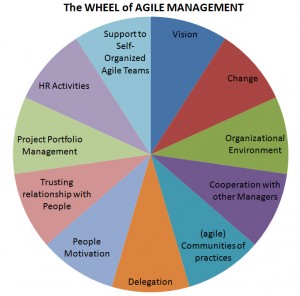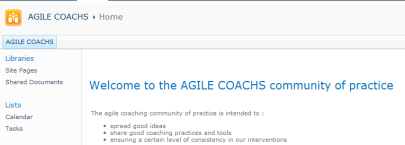Posted by jc-Qualitystreet on 2013/03/18
Inspired by classic coaching tools (like the wheel of life), this wheel of Agile Management helps me in my coaching activities with Managers involved in Agile transformation. The tool is visual and efficient, useful to explore current situation or to prepare coaching.
Thank you to @bangalaurent helping me to formalize it!

The Wheel of Agile Management
Obviously, the wheel is not fixed and can be contextualized …
For details of each category, take a look at this article : Manager 3.0 Being an Agile Manager
How to use it?
This is a self-assessment tool …
- Explain each category (for example what does it mean to support self-organized agile teams? what is behind delegation?)
- Ask the manager to score his sense of satisfaction for each acategory, with 0 (the worst) to 10 (the best) and to join up all the marks (numbers)
- Ask Questions … for example, what did you notice by completing the wheel? Does your Agile Management wheel look and feel balanced? Which category do you want to improve first? With regard to this wheel, what exactly do you want now?
Posted by jc-Qualitystreet on 2011/06/02
Here are the slides (English Version) of the presentation I gave last week at the agile France Conference to introduce Agile & Lean Management with a focus on the role of the Agile Manager:
Posted by jc-Qualitystreet on 2011/02/21
The job of manager is evolving… between opportunity and necessity
After « Our agile manager initiates and supports communities of practice« , this is the second article devoted to the responsibilities of the agile manager.
#2 Support projects and agile self-organized teams… which means:
To promote autonomy, empowerment and self-organization
To remove impediments that the team (broadly defined) cannot raise
To protect the Team
To manage logistics (including setting up an Agile Environment for the team)
To challenge the Team and help improve it to improve its knowledge of the product, technology, methods or tools
In short, it consists in supporting the success of the team, its self-organization and its quest to create value and delight the customer…
You said « self-organizing teams »?
Self-organization is the ability of a team to decide how to organize its own activities to achieve the goals set or solve the problems it faces. The effectiveness of Self-organization has been proven … and in good conditions (mainly depending on management), self-organizing teams naturally evolve into HIGH PERFORMANCE TEAMS.
Self-organization belongs to the foundation of agile… It is one of the 12 principles of the Agile Manifesto (2001): « The best architectures, requirements and designs emerge from self-organizing teams. »
But « the self-organized project team » is also a winning practice, one of the 6 characteristics of leading companies, discovered in 1986 by Takeushi and Nonaka. In The New Product Development Game, the authors pointed out the benefits (speed, flexibility and innovation) of self-organizing teams at Toyota, Honda, Fuji-Xerox, HP or 3M. The article was a source of inspiration for agile methods like Scrum…
Managers, we need you to encourage self-organization
Self-organization is a « common » behavior of any system (related to the fabulous ability to adapt), but to be optimal, self-organization should be both bordered and supported. Agile development teams are no exception to the rule…
To ensure it, the role of the organization is to give a direction, to share a VISION. And managers should define the context by setting limits and constraints and support self-organizing agile teams, to enable them to flourish and perform. Unfortunately, only few managers are able to do it today…
It is clear that the agile self-organized teams must align and evolve with organizational goals. Managers need to articulate what the team does and its own objectives with those of the organization. In parallel and to maintain a successful self-organization, managers will have to know each team member and his work but also provide recognition and appropriate feedback.
In short, without the involvement and commitment of middle management, self-organized teams will… fail.
A new managerial posture is required
Within the population of managers working with agile teams, some are already adapting, for others it is more difficult…
Now in all cases, middle management must show leadership, and leaves behind habits inherited from the past that have little meaning today: command and control, micro-management, or conversely total absence, ignorance and indifference…
Challenging and supporting projects and self-organizing Agile teams will be an important part of the agile manager activity. The Lean & Agile organization offers managers the best opportunity to delegate, to empower people (for real), and to give them the autonomy. It’s a new and positive perspective but that can only work with the presence of the two pillars of Agile Management: (mutual) trust and authenticity.
Posted by jc-Qualitystreet on 2010/12/10
First article dedicated to the responsibilities of the Agile manager, who has a major role to play in the agile adoption. At a time when the era of management 3.0 (a lean and agile management) is announced, the role manager is evolving, between opportunity and necessity
#1 Initiate and support communities of practice… which means
- Give time and resources to agile communities, ScrumMaster, Agile coaches, Product Owner, Agile Testers, Architects, UX Groups …,
- Give feedback on what is done by the communities of practice
- Promote agile communities of practice in the organization
- And why not participate and animate some communities (in a role of coordinator)
Communities of practice are an essential feature of the agile transformation programs we undertake. They are the perfect illustration of the « Yokoten » technique (the horizontal transfer of information and knowledge across the enterprise) used by Lean practionners.

Agile coaching Community of Practice
What is a community of practice?
« Communities of practice are groups of people who share a concern or a passion for something they do and learn how to do it better as they interact regularly. » Etienne Wenger
The idea is not new, but makes sense now, at a time when companies are reconfiguring to become agile, and seek to increase the number of their dedicated, CROSS FUNCTIONAL and self-organized teams. Communities of practice are aligned to this purpose and enable to:
- Exchange on current practices
- Deepen knowledge and expertise
- Spread good ideas, practices and tools in the organization
- Bring together people across teams or product lines
- Coordinate and ensure the necessary consistency between the teams
Our community of practice is not a facebook like!
Its identity is built around the common interest for a specific DOMAIN and the willingness to learn. Passion, learning and commitment are the foundations of the community of practice. For example, I voluntarily belong to the « Agile Coaching » community of practice… because I am an agile coach, highly interested in the topic. But also because I want to contribute, share and discuss with other coaches (experienced or not). And, of course because I want to improve my own PRACTICES.
The same for the ScrumMaster… sometimes feeling alone, isolated within the team, he often needs to challenge himself and wants to discuss and share with the other ScrumMasters of the organization… The community of practice is primarily PRACTICES-ORIENTED, and focus on lessons learned, problems, solutions and vision. The community of practice is collective, dynamic, and collaborative. Members help each other and share information with a COMMUNITY mindset.
And the agile manager?
Communities of practice are not intended to appear in organizations chart. But even if they remain informal, they have a strong need for recognition and support.
Thus the role of the manager is crucial to face the five main challenges (organizational, managerial, community, personal and technical) related to the establishment of such communities in the company. Setting up new rules in the organization to facilitate the communities is often needed. The agile manager will also have to encourage and motivate people to participate, give feedback and handle the technical and logistics aspects to enable communities to express themselves online… and face to face. Because building a community of practice also requires solid relationships between the members, meeting physically and regularly is necessary. It has a cost and must be prepared. The openness of the community towards the outside of the company is also an important point of discussion with management.
At last, enabling the communities of practice to succeed and to flourish in the organization requires the recognition from HR and management of new collaborative skills among communities’ members. A community of practice is collective game.
For both the organization and the individual, the community of practice is the opportunity for knowledge capitalization and improvement. The communities of practice are highly valuable … and this is the responsibility of the agile management to support and develop them!
Posted by jc-Qualitystreet on 2010/12/05
But also a necessity!
The era of agile and lean management (see Management 3.0: Being an Agile Manager) is announced, and many factors contribute to the awareness and the birth of a sense of urgency that can serve as a starting point of willingness to change to lead middle managers to become agile managers.

The Agile Manager: Leadeship & Facilitation
The Enterprise environment
Fast, complex, competitive, changing, the external environment impacts the company itself. Pushed to review its governance, processes and valuable assets, the organization must also differentiate itself from its competitors in terms of knowledge, information sharing, skills and career management. The agile and lean enterprise is an obvious answer to these challenges, and middle managers, first line for these activities, have a major role to play. Whether supporting or opposing, they will be highly impacted by the fundamental changes introduced by an agile and lean approach.
The Rise of agility
Agile methods have spread into projects and in the everyday business life of people. Very popular in IT projects, agility is now everywhere and difficult to avoid. Managers can’t ignore it anymore. Moreover to understand what people actually do and how IT teams work, middle management will require the appropriate level of agile information and training… first steps toward change?
Concrete and visible results
It’s also difficult for middle management to ignore the benefits provided by Agile methods. Agility enables organization to reduce time to market, to improve product quality, to increase project visibility and productivity. Better team satisfaction and better end-user satisfaction are also observed. Agile methods have shown their efficiency and proved that it worked. Ten years after the Agile Manifesto, birth of Agility, agile and Lean practices continue to spread at a « unsustainable » pace 🙂 With the appropriate level efforts, an agile and lean approach gives fantastic results. So, why not applying some of these good practices and using them as a source of inspiration for management activities?
People expectations
Of course some needs and expectations of working people (achievement, recognition, empowerment…) are not new but the agile mindset is! An agile mindset grows within team members working with agile methods, and changes their relationship with others, with work and with their company. Collaboration, courage, feedback, simplicity and respect, the fundamental agile values are now also expected outside of the agile team, and primarly with middle management and hierarchy. Trust and feedback will be the keys.
From a generational point of view, the rapid growing of digital natives (people born after 1978) inside companies also changes the face of the enterprise and how the businesses operate. Digital natives need real time interactions & collaboration, networks, communities and a new management style. Once again, I have the feeling that agile management is a very good option to address the needs of this specific population.
HUMANITY, FACILITATION, COLLABORATION and LEADERSHIP seem to be the key characteristics of the AGILE MANAGER. And inspiration can be easily found in these few principles of lean management:
- Base your management decisions on a long term philosophy… even at the expense of short-term financial goals
- Grow leaders… who thoroughly understand the work, live the philosophy, and teach It to others)
- Develop exceptional people and teams… who follow your company’s philosophy
- Respect your partners and suppliers... by challenging them and helping them improve
- Go and see for yourself… to thoroughly understand the situation
- Make decisions slowly by consensus… thoroughly considering all options implement rapidly
- Become a learning organization... through relentless reflection (Hansei) and continuous improvement (Kaizen)




